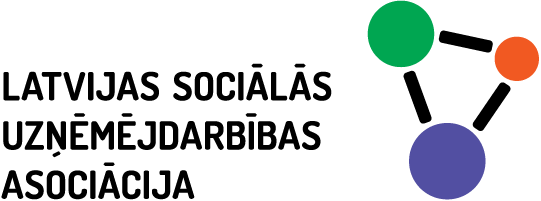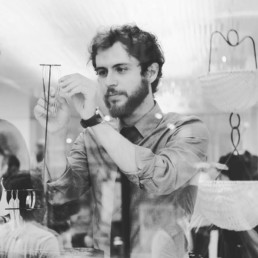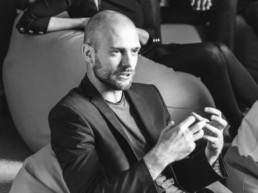Theory of Change
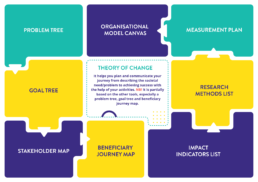
A THEORY OF CHANGE helps you plan and communicate your journey from describing the societal need/problem to achieving success with the help of your activities.
NB! It is partially based on the other tools, especially problem tree, goal tree and beneficiary journey map.
Laura Sukaruka (Kaņepes Kultūras centrs)
“Theory of change allows you to see the whole picture, what your tasks are, and what is not necessary to do since very often we first do something and then think of how it can be included in our framework.
For us, communication is very important, therefore theory of change allows us to see the bigger picture and if all those activities, outcomes correspond to our bigger vision.”
What is it?
Do you want to understand if your plan to achieve your impact goal really makes sense? Use the Theory of Change tool to carefully map out the steps between the problems you would like to solve and your impact goal you are inspired to achieve.
Theory of Change can be used by any organization and whenever necessary, but it is most helpful to develop a theory at the beginning of designing your solution. The tool can also be of excellent help when you need to present your organisation briefly yet comprehensively.
The tool is called a theory of change because it helps you create a theory of how you think you will create positive changes with your activities.
Like any theory, your theory of change can and must be tested in practice before you can claim that the theory is true..
Here is an example about a cyberbullying prevention program.
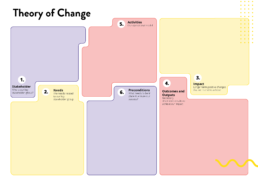
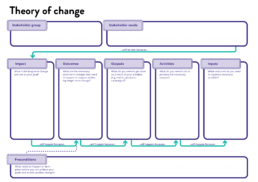
This is a quick explanation of your thought process when creating your theory of change.
Think about your activities.
Now think about your desired impact.
How do your activities lead to your impact?
What are all the steps in between that? Write those steps down according to the guide.
That’s your Theory of Change.
The difference between these two examples.
The first one (6 boxes) is a simpler version. It’s good to use it when you don’t have too much time or when you need to prepare a presentation for external stakeholders. It’s quite easy to read and understand from an outsider’s perspective.
The second one (7 boxes) is a more thorough version. It can be better to use this one when you need to plan or analyse more carefully what your organisation should do or has done.
You can also choose the level of how deep you want to go based on why you decided to create a theory of change. The more specific and detailed it is, the better.
You can either have one theory of change for your entire organisation or one for each beneficiary group if you want to make most of the tool. And an average youth organisation has 1-3 beneficiary groups so it may make sense to create 1-3 theories of change too.
- Fill in the boxes,
- following the numbers in top right corner of each box (6 boxes) or
- according to guiding lines and arrows from left to right (7 boxes).
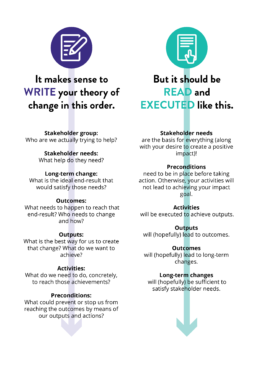
Make use of all information you have written down with previous tools.
- Make sure to differentiate between outputs and outcomes. Outputs are the actions or items that lead to outcomes. For example, a clean-looking website is an output, which leads to increased traction, an outcome. Outcomes describe the change you’ve created (not describing what you did but what happened as a result).
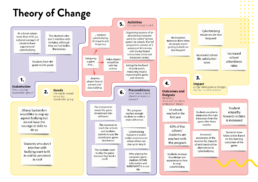
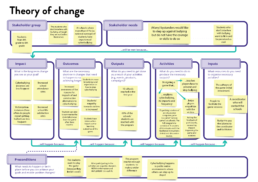
Why to use it?
☑ This is the one tool that covers all the important aspects of planning and managing your impact.
☑ To identify which parts of your work need the most attention to better manage your impact. For example:
- How clearly have we defined our stakeholder group?
- How well do we understand the needs of our stakeholder group?
- How precisely have we defined the outcomes and impacts we would like to achieve?
- What are the necessary and sufficient activities to move from the stakeholders´ current needs to the positive future?
- Which preconditions need to be in place so that our activities would be successful in creating an impact?
☑ The simpler/shorter version of the tool also helps you communicate your aims, activities and impact.
When to use it?
☑ To place the information from the other tools into one place, e.g. from your problem tree, goal tree and beneficiary journey map.
☑ If you have new people joining the team, you can use the theory of change to effectively introduce your organisation and make sure they understand the “big picture”.
☑ You can use it to communicate your organisation externally too, including references in project applications.
☑ It is very useful to come back to your theory of change with your team once in a while to be sure whether you are following your strategy, anything has changed or should be changed.

